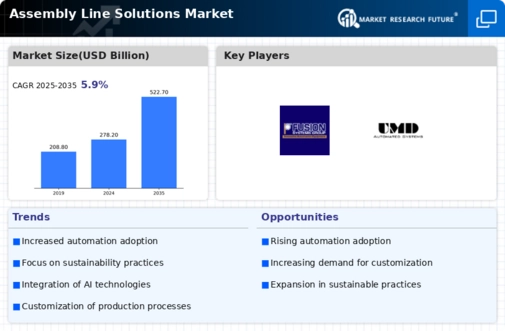Market Analysis
In-depth Analysis of Assembly Line Solutions Market Industry Landscape
The global assembly line solutions market is set to reach US$ 990.3 BN by 2032, at a 5.90% CAGR between years 2023-2032. The market of assembly line solutions models the dynamics’ intricate impact on manufacturing engineering. In such context, such an approach largely affects manufacturing as manufacturers that use streamlined production processes want to improve their working systems so that they can produce commodity products better and faster. Their valuable contribution towards increased productivity, reduced operational costs and for the quality and consistency of goods is achieved via implementing assembly process solutions. The global push toward automation in manufacturing is among the top forces behind this market’s development. In a market where industries are driven by efficiency and output, the demand for assembly line solutions has been on a high over the past few years. Assembly lines are required everywhere due to automated processes because of tedious manual work demands at such fast-paced times today. Perhaps the most associated market dynamics for assembly line solutions are those revolving around technological advancements.
Innovations in robotics; AI and IoT are rendering traditional assembly lines into smart, intelligent networks. These advanced technologies not only improve the rate and accuracy of assembly but equally allow real-time monitoring and data analytics for better decision-making decisions, which impact continuous improvement. The companies made sure to manage the investment in society with advanced assembly line solutions as it is helpful for not only the automotive industry or electronics but also any other where computer touch increases transfer of speed and would yield better results. International economic indicators are very important for the formation of economics related to production lines. Companies that consider the implementation of assembly line technologies or their enhancements are faced with a choice influenced by economic stability, market demand and industry-specific developments. In times of stagnation and economic slowdowns, manufacturers are likely to try and suffice in cost-effective ways to remain competitive. On the flip side, high economic growth may result in greater investments on cutting edge assembly line technologies that satisfy tremendous demand. Competitive rivalry in the assembly line solutions market is characterized by different manufacturers who vendor various level of technology and services.
Robotics developers, automation software manufacturers, and integrated assembly line systems suppliers compete for improving their offerings that respond to the individual demands of specific industries. Product innovation, reliability, and ability to adjust in terms of changing needs when it comes to manufacturing are also a source of differentiation. Competition further leads to continuous innovations in developing weldable design and other assembly line solutions that respond to the various demands that modern manufacturing especially entails. How government regulations and ruling industry standards translate to the market dynamics of assembly line solutions is another area of focus. The obligations of manufacturers and providers are official uniform standards for occupational safety therefore they should follow this rule, as well as environmental regulations and labor laws. The compliance with laws and regulations makes sure that enduring assembly line solutions assisted many industries and this device is considered as ideal for operations in manufacturing, saving time along with labor, environment gets safeguarded properly and provides consultation to the staff regarding authorized practices.





Leave a Comment